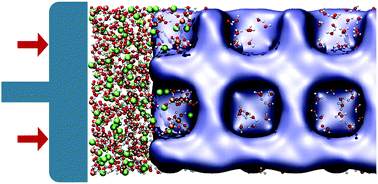Forced intrusion of water and aqueous solutions in microporous materials: from fundamental thermodynamics to energy storage devices†
Abstract
We review the high pressure forced intrusion studies of water in hydrophobic microporous materials such as zeolites and MOFs, a field of research that has emerged some 15 years ago and is now very active. Many of these studies are aimed at investigating the possibility of using these systems as energy storage devices. A series of all-silica zeolites (zeosil) frameworks were found suitable for reversible energy storage because of their stability with respect to hydrolysis after several water intrusion–extrusion cycles. Several microporous hydrophobic zeolite imidazolate frameworks (ZIFs) also happen to be quite stable and resistant towards hydrolysis and thus seem very promising for energy storage applications. Replacing pure water by electrolyte aqueous solutions enables to increase the stored energy by a factor close to 3, on account of the high pressure shift of the intrusion transition. In addition to the fact that aqueous solutions and microporous silica materials are environmental friendly, these systems are thus becoming increasingly interesting for the design of new energy storage devices. This review also addresses the theoretical approaches and molecular simulations performed in order to better understand the experimental behavior of nano-confined water. Molecular simulation studies showed that water condensation takes place through a genuine first-order phase transition, provided that the interconnected pores structure is 3-dimensional and sufficiently open. In an extreme confinement situations such as in ferrierite zeosil, condensation seem to take place through a continuous supercritical crossing from a diluted to a dense fluid, on account of the fact that the first-order transition line is shifted to higher pressure, and the confined water critical point is correlatively shifted to lower temperature. These molecular simulation studies suggest that the most important features of the intrusion/extrusion process can be understood in terms of equilibrium thermodynamics considerations.



 Please wait while we load your content...
Please wait while we load your content...